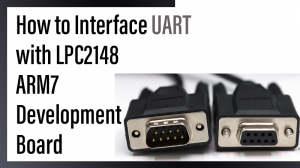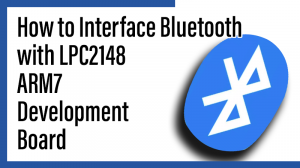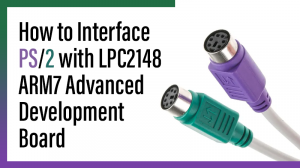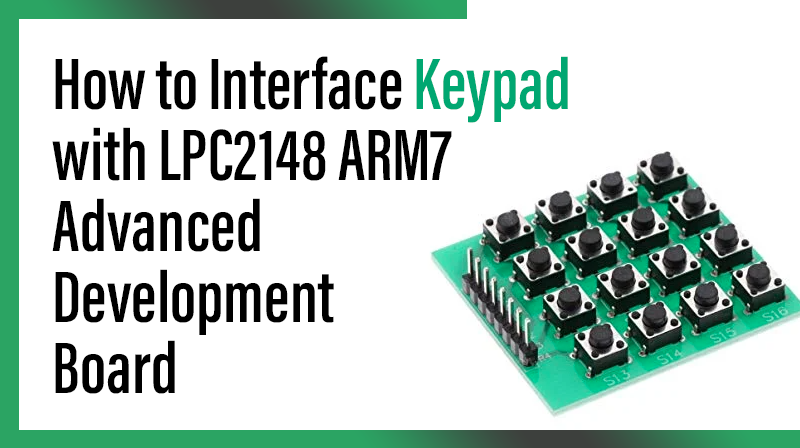
How to Interface Keypad with LPC2148 – ARM7 Advanced Development Board
The ARM7 LPC2148 Advanced Development Board is specifically designed to help students to master the required skills in the area of embedded systems. The kit is designed in such way that all the possible features of the microcontroller will be easily used by the students. The kit supports in system programming (ISP) which is done through serial port.
NXP’s ARM7 (LPC2148), ARM Advanced Development Board Kit is proposed to smooth the progress of developing and debugging of various designs encompassing of High speed 32-bit Microcontrollers.
SPI (Serial Peripheral Interface)
Serial Peripheral Interface (SPI) is a synchronous serial data protocol used by microcontrollers for communicating with one or more peripheral devices quickly over short distances. It can also be used for communication between two microcontrollers.
Ethernet
Ethernet is the most widely-installed local area network (LAN) technology. An Ethernet LAN typically uses coaxial cable or special grades of twisted pair wires. Ethernet is also used in wireless LANs. The most commonly installed Ethernet systems are called 10BASE-T and provide transmission speeds up to 10 Mbps. Devices are connected to the cable and compete for access using a Carrier Sense Multiple Access with Collision Detection (CSMA/CD) protocol.
The ENC28J60 Ethernet Controller
Microchip’s ENC28J60 controller is a 28-pin, 10BASE-T standalone Ethernet Controller, with on board MAC & PHY, 8 Kbytes of Buffer RAM and an SPI serial interface used as an Ethernet network interface for any microcontroller equipped with SPI interface. So the microcontroller can then control remotely any hardware.
Interfacing SPI-Ethernet
Fig. 1 shows how to interface the SPI-Ethernet to microcontroller. With an SPI connection there is always one master device (usually a microcontroller) which controls the peripheral devices. Typically there are three lines common to all the devices,
☞Master In Slave Out (MISO) – The Slave line for sending data to the master,
☞Master Out Slave In (MOSI) – The Master line for sending data to the peripherals,
☞Serial Clock (SCK) – The clock pulses which synchronize data transmission generated by the master, and
☞Slave Select pin – the pin on each device that the master can use to enable and disable specific devices. When a device’s Slave Select pin is low, it communicates with the master. When it’s high, it ignores the master.
This allows you to have multiple SPI devices sharing the same MISO, MOSI, and CLK lines.
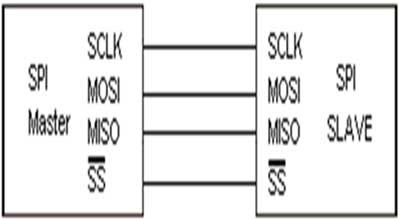
The Ethernet buffer contains transmit and receive memory used by the Ethernet controller. The entire buffer is 8 Kbytes, divided into separate receive and transmit buffer spaces. The sizes and locations of transmit and receive memory are fully programmable by the host controller using the SPI interface. Any space within the 8- Kbyte memory, which is not programmed as part of the receive FIFO buffer, is considered to be the transmit buffer.
Interfacing SPI-Ethernet with LPC2148
In SPI, the clock signal is controlled by the master device LPC2148 Advanced Development Board. All data is clocked in and out using this pin. These lines need to be connected to the relevant pins on the LPC2148 Advanced Development Board. Any unused GIO pin can be used for CS, instead pull this pin high. The ENC28J60 requires a single per packet control byte to precede the packet for transmission to Microcontroller. An IP address is used to access the Ethernet control. The ENC28J60 SPI connections with LPC2148 have four I/O lines required.
Pin Assignment with LPC2148
Circuit Diagram to Interface SPI-Ethernet with LPC2148
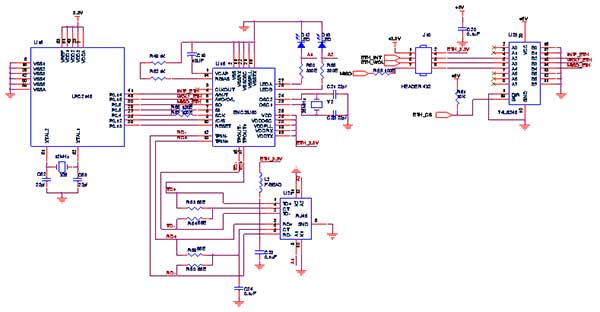
Source Code
The Interfacing UART with LPC2148 program is very simple and straight forward, which controls the LED & Switches in LPC2148 Advanced Development Board from Ethernet through SPI. In C programs are written in Keil software. When we select LED or Switch in Internet Explorer by using IP address then the output is enabled in LPC2148 controller.
C Program to interface Ethernet with LPC2148
***************************************************************************************************
Title : Program to control LED & Switches from Ethernet using SPI
***************************************************************************************************
#include
#include "string.h"
#include "ENC28J60.h"
#include "c_ctype.h"
#include "conv.h"
#include "Utility.h"
#define ENC28J60_HALFDUPLEX 0
#define ENC28J60_FULLDUPLEX 1
const unsigned char httpHeader[] = "HTTP/1.1 200 OK\n Content-type: ";
// HTTP header const unsigned char httpMimeTypeHTML[] = "text/html\n\n";
const unsigned char httpMimeTypeScript[] = "text/plain\n\n";
unsigned char httpMethod[] = "GET /";
const char *indexPage = "\\ for(i=0;i<8;i++>
\{str+=\"LED #\"+i+\"\";
\ if(PORT1_23_16&(1<<i)){str+=\"ON\";
}
\ else {str+=\"OFF\";
}
\ str+=\"Toggle\";
}
\ document.write(str) ;
\\\ This is HTTP request #
unsigned char myMacAddr[6] = {0x00, 0x1f, 0xD0, 0xE3, 0x90, 0xDD}; // my MAC address
unsigned char myIpAddr[4] = {192, 168, 1, 60}; //IP address unsigned char getRequest[15]; // HTTP request buffer
unsigned char dyna[31]; // buffer for dynamic response
unsigned long httpCounter = 0; // counter of HTTP requests
int main (void)
{
PINSEL0 = 0;
PINSEL1 = 0;
PINSEL2 &= 0x0000000C;
delay_Nx10cyc(599999); // Delay 0,1s
IODIR1 &= 0x00FFFFFF; // Set P1[31..24] as inputs
IODIR1 |= 0x00FF0000; // Set P1[23..16] as outputs
IOCLR1 |= 0x00FF0000; // Turn off LEDs // starts ENC28J60 with : RST bit on IOPIN0.13, CS bit on IOPIN0.12, my MAC & IP address, full duplex ENC28J60_Init(&IOPIN0, 13, &IOPIN0, 12, myMacAddr, myIpAddr, ENC28J60_FULLDUPLEX) ;
while (1)
{
ENC28J60_doPacket(); // incoming Ethernet packets /* * add your stuff here if needed * ENC28J60_doPacket() must be called as often as possible * otherwise packets could be lost */
}
}
unsigned long putConstString(const char *s)
{
unsigned long ctr; ctr = 0; while(*s)
{
ENC28J60_putByte(*s++); ctr++;
}
return(ctr);
}
unsigned long putString(char *s)
{
unsigned long ctr; ctr = 0;
while(*s)
{
ENC28J60_putByte(*s++); ctr++;
}
return(ctr);
}
unsigned long ENC28J60_userTCP(unsigned char *remoteHost, unsigned long remotePort, unsigned long localPort, unsigned long reqLength)
{
unsigned long len, // my reply length i, // general purpose integer bitMask; // for bit mask i = (unsigned long) remoteHost; i = remotePort; i = reqLength;
len = 0;
bitMask = 0;
if (localPort != 80) return(0) ;
for (i = 0; i < 10; i++) getRequest[i] = ENC28J60_getByte();
getRequest[i] = 0;
if (memcmp(getRequest, httpMethod, 5)) return(0);
httpCounter++; // one more request done if (getRequest[5] == 's') { len = putConstString(httpHeader); // HTTP header
len += putConstString(httpMimeTypeScript);
IntToStr(0, dyna);
len += putConstString("var AN0=");
len += putString(dyna);
len += putConstString(";"); // add AN1 value to reply
IntToStr(0, dyna);
len += putConstString("var AN1=");
len += putString(dyna);
len += putConstString(";"); // add
PORT1[31..24] value (buttons) to reply
len += putConstString("var PORT1_31_24=");
IntToStr(((IOPIN1 >> 24) & 0xFF), dyna);
len += putString(dyna);
len += putConstString(";"); // add
PORT1[23..16] value (LEDs) to reply
len += putConstString("var PORT1_23_16=");
IntToStr(((IOPIN1 >> 16) & 0xFF), dyna);
len += putString(dyna);
len += putConstString(";"); // add HTTP requests counter to reply IntToStr(httpCounter, dyna);
len += putConstString("var REQ=");
len += putString(dyna);
len += putConstString(";");
}
else if (getRequest[5] == 't')
{
if (isdigit(getRequest[6]))
{
bitMask = getRequest[6] - '0'; // ASCII to integer
bitMask = 1 << (bitMask + 16); // create bit mask
if ((IOPIN1 & bitMask) != 0) // Toggled LED
IOCLR1 |= bitMask;
else
IOSET1 |= bitMask;
}
}
if (len == 0) // what do to by default
{
len = putConstString(httpHeader); // HTTP header
len += putConstString(httpMimeTypeHTML); // MIME type
len += putConstString(indexPage); // HTML page
}
return (len);
}
unsigned long ENC28J60_userUDP(unsigned char *remoteHost, unsigned long remotePort, unsigned long destPort, unsigned long reqLength)
{
unsigned long len; // my reply length
unsigned char *ptr;
ByteToStr(remoteHost[0], dyna); // first IP address
byte dyna[3] = '.';
ByteToStr(remoteHost[1], dyna + 4); // second
dyna[7] = '.';
ByteToStr(remoteHost[2], dyna + 8); // third
dyna[11] = '.';
ByteToStr(remoteHost[3], dyna + 12); // fourth
dyna[15] = ':'; // add separator
IntToStr(remotePort, dyna + 16);
dyna[22] = '[';
IntToStr(destPort, dyna + 23);
dyna[29] = ']';
dyna[30] = 0; // the total length of the request is the length of the dynamic string plus the text of the request
len = 30 + reqLength; // puts the dynamic string into the transmit buffer ptr = dyna;
while (*ptr) ENC28J60_putByte(*ptr++); // then puts the request string converted into upper char into the transmit buffer
while (reqLength--) ENC28J60_putByte(toupper(ENC28J60_getByte()));
return (len); // back to the library with the length of the UDP reply
}To compile the above C code you need the KEIL software. They must be properly set up and a project with correct settings must be created in order to compile the code. To compile the above code, the C file must be added to the project.
In KEIL, you want to develop or debug the project without any hardware setup. You must compile the code for generating the HEX file. In debugging Mode, you want to check the port output without the LPC2148 Advanced Development Board.
The Flash Magic software is used to download the hex file into your microcontroller IC LPC2148 through UART0.
Testing the SPI-Ethernet with LPC2148
Give +3.3V power supply to LPC2148 Advanced Development Board; the SPI-Ethernet is connected with LPC2148 Advanced Development Board. Connect your board to a hub with a straight cable. LEDA should now turn on with LEDB still blinking. LEDA ON means that the adapter is correctly linked to the network. The network link LED of the other side hub should also turn on.
Open the Internet Explorer window and give the IP address. If the entire connections are connected correctly, then the IP address display the LED, switch levels.
Now you can control the input & output port lines (LED & switch) of LPC2148 Advanced Development Board from Internet Explorer through SPI – Ethernet. If you are not reading any output from LED, then you just check the jumper connections & check the LED is working.
If you are not controlled the I/O port lines of LPC2148 Advanced Development Board from Internet Explorer, then you just check the IP address & Ethernet connections. Otherwise you just check the code with debugging mode in KEIL. If you want to see more details about debugging just see the videos in below link.
☞How to Create & Debug a Project in KEIL.
General Information
☞For proper working use the components of exact values as shown in Circuit file. Wherever possible use new components.
☞Solder everything in a clean way. A major problem arises due to improper soldering, solder jumps and loose joints.
☞Use the exact value crystal shown in schematic.
☞The straight cable only used between LPC2148 Advanced Development Board hub & the network cable hub.
☞Don’t plug the ENC28J60 in its socket, then power to the board and verify the 3.3V power supply on each pin of the ENC.
☞More instructions are available in following articles,
How to Interface LEDs with LPC2148 – ARM7 Advanced development board

